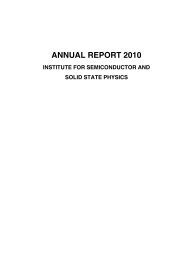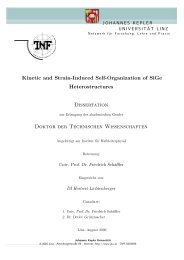Diplomarbeit Diplom-Ingenieur - Institut für Halbleiter
Diplomarbeit Diplom-Ingenieur - Institut für Halbleiter
Diplomarbeit Diplom-Ingenieur - Institut für Halbleiter
Create successful ePaper yourself
Turn your PDF publications into a flip-book with our unique Google optimized e-Paper software.
22<br />
The origin of the third contrast mechanism is interference of differently diffracted<br />
e-beams. This contrast allows to resolve lattice fringes in High Resolution<br />
Microscopy which is treated in section 3.4.<br />
Figure 3.4: In regions with low mass thickness more electrons are forward scattered to<br />
small angles and can be collected by the objective aperture. This causes a higher intensity<br />
in the formed image. In higher mass thickness regions more scattering events occur<br />
causing darker regions in the image. [32]<br />
3.3.2 Dark Field and Bright Field imaging<br />
Since the diffraction pattern of the crystal is reproduced in the focal plane of the<br />
objective lens and the objective aperture is located in the same plane, a distinct<br />
diffraction spot can be chosen in the DP mode for real image formation. To do that all<br />
other spots are masked by the aperture and only the electrons of one beam are<br />
collected by the intermediate lens. BF images are formed by collecting only the<br />
electrons of the (000) peak by the objective aperture and show strong mass thickness<br />
contrast.<br />
On the other hand, collecting the electrons of any diffraction spot can show<br />
contrast in the real image, whose origin are different lattice parameters or a different<br />
structure form factor. Both of these properties are a part of the extinction distance ξg<br />
(egn. 3.9) which is a determining factor of the amplitude of a scattered beam. This











